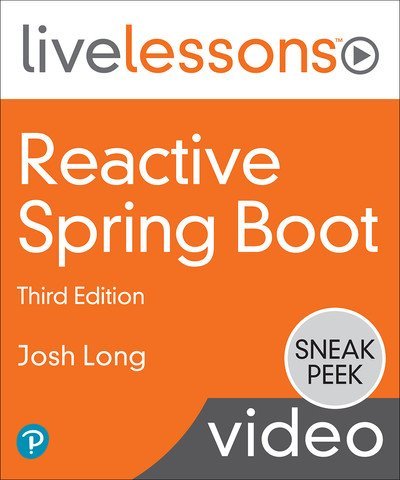
MP4 | Video: AVC 1280 x 720 | Audio: AAC 48 Khz 2ch | Duration: 07:46:07 | 14.12 GB
Genre: eLearning | Language: English
Spring is the most used framework for building services and applications and getting them to production. Today’s applications need to scale more and more to handle more users and content with the increasing demand. Reactive Spring Boot LiveLessons 3rd Edition, by Josh Long, Spring Developer Advocate, introduces key concepts of reactive programming and examines different aspects of the Spring ecosystem that lend themselves to the functional and reactive style of programming.
These videos not only show you where to start and how to build these applications, but they also provide a solid foundation that will allow you to apply the skills learned to other parts of the Spring ecosystem that build on these core concepts. The 3rd Edition has been updated and expanded to cover GraphQL.
Customer Review:
(5 Stars) “A great walkthrough of all the reactive capabilities of Spring Boot, and then some!”
O’Reilly Online Learning reviewer
Skill Level
Intermediate
Learn How To
Examine the different aspects of the Spring ecosystem that lend themselves to the functional and reactive style of programming
Explore Reactive Data Access using Spring Data and Spring Data MongoDB
Understand the Reactive Streams specification as a compatibility layer and how to use the
Reactive Stream types as a mechanism for interoperability across OS projects
Test reactive applications
How to consume data from a publisher in Spring Integration and how to consume data from a publisher in Spring Cloud Stream
Use Spring Cloud Function
Build Edge Services
Who Should Take This Course
Existing or new Spring users
Experienced Java developers
Course Requirements
Basic Java familiarity. The course uses Java 8, although Spring Boot and most Spring projects support Java 6.
Lesson Descriptions
Lesson 1, “Basics,” examines what motivates the move to reactive programming and how it is supported in the Reactive Streams specification.
Lesson 2, “Data,” covers the importance of data and how Spring supports non-blocking data access for any NoSQL and SQL data stores.
Lesson 3, “HTTP Services,” focuses on what reactive programming means in an HTTP environment. It introduces functional reactive HTTP handlers, `@RestController`-style controllers, reactive server-sent event streams and more.
Lesson 4, “WebSockets,” focuses on Websockets, a binary protocol that supports bi-directional communication. This lesson examines how websockets, which are an extension to HTTP, integrate with Reactive Streams.
Lesson 5, “HTTP Clients,” briefly reviews the `Webclient`, the reactive HTTP client. It also discusses some patterns that clients will care about when dealing with distributed services. After incrementally building up from basic reactive pipelines to data access and then HTTP and websockets, Lesson 6, “RSocket,” introduces RSocket. RSocket is a binary protocol that supports full duplex bi-directional communication, fully integrated in Spring Framework 5.2 and Spring Boot.
Lesson 6, “RSocket,” covers this protocol designed by engineers at Netflix and then Facebook. It’s a binary protocol that supports bi-directional communication and used for service-to-service communication. This lesson covers the motivations for using RSocket, Raw RSocket and RSocket in Spring.
Lesson 7, “GraphQL,” a protocol developed at Facebook, is a way to build data integration gateways and changes the way edge services are built. This lesson introduces GraphQL, GraphQL Schema and the Domain. It also covers low level “RuntimeWiring Configurer”, queries, mutations and subscriptions. Josh Long also introduces the new Spring GraphQL.
Lesson 8, “Security,” shows how Spring Security works flawlessly to protect HTTP and RSocket-based services.
Lesson 9, “Gateway,” examines how to use Spring Cloud Gateway and how it is used to act as an API gateway for HTTP- and RSocket-based services.
Lesson 10, “Reactive Streams Redux,” focuses on the Reactive Streams specification as a compatibility layer and shows how to use the Reactive Stream types as a mechanism for interoperability across opensource projects like Akka Streams, Vert.x. Spring Web Flux, and Spring Data.
Lesson 11 “Reactive Streams Redux,” briefly reviews testing reactive applications and covers Reactive data access, Reactive web services, and how to test reactive microservices.
Password/解压密码www.tbtos.com